Hampi, Virupaksha Temple
Historical background
Hampi, on the south bank of the Tungabhadra River, has been a sacred site since c. the 8th-9th century. Its main temple, dedicated to Virupaksha, an aspect of Shiva, was a major centre of religious activity well before the Vijayanagara period (14th to 16th centuries) and continues to be an important pilgrimage place.
Read more
The temple was enlarged and refurbished at various points in time. One of the most noteworthy additions is the open pillared hall abutting the sanctuary and its antechambers. Built in 1509/10 by the emperor Krishnadevaraya (r. 1509-1529) to celebrate his coronation, its ceiling is adorned by a set of carefully laid out paintings organised in eight registers. The central part displays two crucial episodes of the Shaiva lore: Shiva as Tripurantaka, destroying the three aerial cities of the asuras, and Shiva as Kamadahana, incinerating with his glance the god of love, Kama, who dared to disturb his meditation. This incident is particularly important, as it is deemed to have taken place on Hemakuta Hill, in the immediate proximity of the temple.
Further mythological themes are: the wedding of Shiva and Parvati, Rama winning Sita’s hand at the archery competition; their wedding; and Arjuna winning Draupadi’s hand by hitting the revolving fish target. Vishnu’s ten avataras, the eight guardians of the directions and three large panels depicting Brahma, Shiva and Vishnu with their consorts grace the western end of the hall. A large, faded panel on the easternmost beam supporting the ceiling depicts the epic battle between Arjuna against the Trigartas and Kauravas, who stole the cattle of King Virata, an episode drawn from the Virata Parva of the Mahabharata. The seventh and eight registers depict battle scenes and the procession of the Vidyaranya, the pontiff, arriving at the shrine of Virupaksha. A set of medallions, displaying various themes, decorate the south, west, and north beams supporting the ceiling.
Until recently the general consensus was that the paintings were coeval with the mandapa. However, the details of the costumes, turbans and weapons appearing in the seventh and eight registers have been crucial for reassessing the date of the murals. The soldiers’ jackets display a pattern strongly reminiscent of the tiger stripes pattern popular at the time of Tipu Sultan. The palanquin in which the Vidyaranya is carried is very similar to those in fashion in the early 19th century. These elements alone would date the paintings between the close of the 18th century and the early decades of the 19th. Furthermore, in the seventh register, groups of soldiers carry muskets with bayonets: this detail rules out a date before the end of the 18th century. The limited palette and the conspicuous absence of European pigments suggest a date between 1830 and 1840, the period in which the temple was refurbished by order of the then District Collector, Mr. F.W. Robertson. It is thus probable that it is that the paintings were executed at that time.
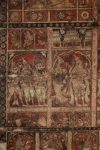
Date: First half of the 19th century
Description: The wedding of Shiva and Parvati, detail: Tumburu, Narada and Bhairava (?), Vishnu and Sarasvati. Above the main scenes (left), kinnaras playing musical instruments and buildings inhabited by rishis (right). Below the main scenes: a dancer, two kettledrum and four trumpet players.
Location: Karnataka Temple;Virupaksha Temple;Hampi
Positioning: Open mandapa, ceiling, second row from west
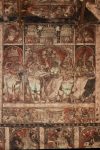
Date: First half of the 19th century
Description: The wedding of Shiva and Parvati, detail. At the centre, Shiva and Parvati, her father Himavan giving her away. Immediately on the left, near Shiva is Brahma. On the right, behind Himavan, are Mena (?) and another female figure. Immediately above the divine couple, are Purushamriga (left); Surabhi (right) and in the corners kinnaras strew flowers on Shiva and Parvati. Beneath the main scene: Crouching Nandi, flanked by eight armed figures, possibly the dikpalas.
Location: Karnataka Temple;Virupaksha Temple;Hampi
Positioning: Open mandapa, ceiling, second row from west
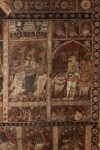
Date: First half of the 19th century
Description: The wedding of Shiva and Parvati, detail; Three goddesses bearing trays; Bhringi, Adhikaranandi and Ganesha. Immediately above are kinnaras playing musical instruments and buildings inhabited by rishis. Below: Musicians playing trumpets and kettledrums, and a dancer.
Location: Karnataka Temple;Virupaksha Temple;Hampi
Positioning: Open mandapa, ceiling, second row from west
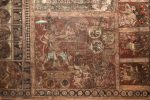
Date: First half of the 19th century
Description: Shiva as Tripurantaka. The god mounted on a chariot driven by Brahma, and whose wheels are the Sun and the Moon, destroys with a magic arrow, whose tip is Vishnu, the three aerial cities of the asuras. Mount Meru is his bow, and the serpent Vasuki is the bow’s string.
Location: Karnataka Temple;Virupaksha Temple;Hampi
Positioning: Open mandapa, ceiling, fourth row from west
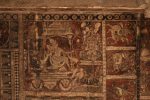
Date: First half of the 19th century
Description: Kama, accompanied by his wife, Rati, and armed with a sugarcane bow and flower arrows, arrives on his parrot-drawn chariot near the spot where Shiva is steeped in meditation and disturbs him. The powerful flame which then issues from Shiva’s third eye incinerates him.
Location: Karnataka Temple;Virupaksha Temple;Hampi
Positioning: Open mandapa, ceiling, fourth row from west
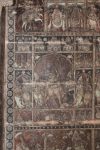
Date: First half of the 19th century
Description: Rama, flanked by Janaka and Sita wins the archery contest. Two couples flank the main tableau. The seven rishis are shown in the vignettes on the left and the right. Celestial beings and rishis inhabit the five buildings at the top of the composition. Beneath the main scene is a lying figure, possibly Ravana. According to some re-tellings of the epic, he was among the princes present at the archery contest and fainted when Rama won.
Location: Karnataka Temple;Virupaksha Temple;Hampi
Positioning: Open mandapa, ceiling, sixth register from west
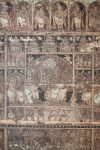
Date: First half of the 19th century
Description: Rama and Sita’s wedding. On the left Sita accompanied by Janaka and his wife, on the right Rama; Dasharatha and Kausalya. Flanking the main tableau, on the left are Vasishtha and Janaka’s court chaplain, Shatananda; on the right, one of Dasharatha’s other queens (?) and Vishvamitra. Rows of courtly figures and rishis in buildings enliven the upper portion of the composition. The lower part accommodates four male courtly figures and eight ascetics. Their different attires indicate the various orders they belong to.
Location: Karnataka Temple;Virupaksha Temple;Hampi
Positioning: Open mandapa, ceiling, sixth row from west
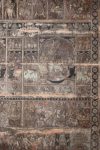
Date: First half of the 19th century
Description: Arjuna wins Draupadi’s hand. Flanked by Drupada and by Draupadi, Arjuna, standing on two spherical devices, aims at the matsya yantra (revolving fish target) by looking at its reflection in a cauldron of water, which, according to the tradition, was continuously stirred. To the left are three crowned male figures, possibly Arjuna’s brothers; Yudhishthira, Bhima and Nakula. On the right two male figures could be Sahadeva and Krishna, and an unidentified third person. The vignette on the right shows two deities, possibly Shiva and Vishnu; the one on the left, four crowned figures. The upper part of the panel is occupied by the rishis-in-buildings motif. The central part of the lower portion accommodates six ascetics in different attires indicating their different religious orders, and at the corners crowned male and female figures.
Location: Karnataka Temple;Virupaksha Temple;Hampi
Positioning: Open mandapa, ceiling, sixth row from west
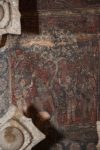
Date: First half of the 19th century
Description: Krishna steals the clothes of the gopis.
Location: Karnataka Temple;Virupaksha Temple;Hampi
Positioning: Open mandapa, ceiling, seventh row from west
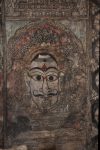
Date: First half of the 19th century
Description: The Virupaksha linga enshrined in the temple’s sanctuary.
Location: Karnataka Temple;Virupaksha Temple;Hampi
Positioning: Open mandapa, ceiling, eighth row from the west
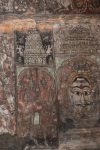
Date: First half of the 19th century
Description: The Virupaksha linga enshrined in the temple. Nandi stands under the bells hanging from the ceiling of the antechamber before the sanctuary.
Location: Karnataka Temple;Virupaksha Temple;Hampi
Positioning: Open mandapa, ceiling, eighth row from west
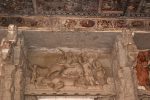
Date: First half of the 19th century
Description: Vignettes, from left: Vishnu reclining on Shesha; An ascetic in the wilderness and many animals; Ascetics worshipping nagas; Warrior killing a lion; Man on elephant killing a tiger; Matsyendranath and disciples; Ascetics with a number of animals; Yashoda churning butter and Krishna stealing it.
Plaster sculptures: Durga killing Mahishasura.
Location: Karnataka Temple;Virupaksha Temple;Hampi
Positioning: Open mandapa, beam supporting the ceiling, south (from east to west)
« Previous 1 2 3 4 Next »